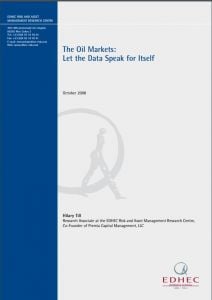

The Oil Markets: Let the Data Speak for Itself
In US dollar terms, crude oil prices increased 525% from the end of 2001 through July 31st, 2008. Was this rally yet another speculative bubble? Specifically, was the oil-price rally based on speculative excess rather than fundamental supply-and-demand factors? In a new position paper, “The Oil Markets: Let the Data Speak for Itself”, we argue that when the oil supply-and-demand balance becomes sufficiently tight and that when effective OPEC spare capacity becomes sufficiently low that it is logical to see very high prices to ration demand and/or encourage additional supply. That is the job and message of price, even if this message is unpopular.
Author(s):
Summary:
In US dollar terms, crude oil prices increased 525% from the end of 2001 through July 31st, 2008. Was this rally yet another speculative bubble? Specifically, was the oil-price rally based on speculative excess rather than fundamental supply-and-demand factors? In a new position paper, “The Oil Markets: Let the Data Speak for Itself”, we argue that when the oil supply-and-demand balance becomes sufficiently tight and that when effective OPEC spare capacity becomes sufficiently low that it is logical to see very high prices to ration demand and/or encourage additional supply. That is the job and message of price, even if this message is unpopular.
Register to download PDF
Register/Log in| Type : | EDHEC Publication |
|---|---|
| Date : | 10/07/2008 |
| Keywords : |
Commodities |

